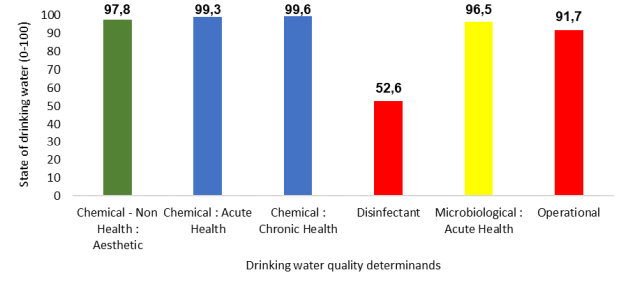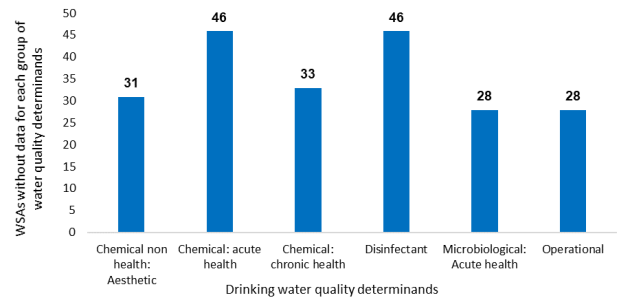National drinking water quality reporting for building consumer confidence (II)
5 February 2020
INTRODUCTION
Numerous concerns have been raised about the quality of drinking water in South Africa. News reports have suggested that some international tour advisors now warn tourists about the unsafe state of South African tap water. [1] Similarly, Hammanskraal residents (Northern Tshwane) have expressed discontent with the quality of their tap water. With the support of the Organisation Undoing Tax Abuse, The South African Human Rights Commission and the Council for Scientific and Industrial Research (CSIR), the residents’ claims have been substantiated. The CSIR laboratory analysis results of the Hammanskraal tap water revealed that their drinking water had elevated concentrations of nitrites and nitrates (chemical determinands) and Escherichia coli bacteria (microbiological determinants). The concentrations of the three-drinking water quality determinands were found to be above the South African National Standard (SANS) 241 limits. [2]
In response, the Department of Human Settlement, Water and Sanitation (DHSWS) disputed claims of poor-quality tap water. The Department assured the nation that South African drinking water was safe for human consumption. The Department also asserted that municipalities and Water Service Authorities (WSAs) provide water that is compliant with national standards that are compatible with World Health Organisation (WHO) drinking water quality guidelines.[3]
But to what extent do WSAs in fact adhere to those standards? On the Hammanskraal tap water quality crisis, the City of Tshwane Metropolitan Municipality disputed the poor water quality claims regardless of contrary laboratory analysis. Disputing empirical evidence that backed consumer’s claims does nothing but weaken the authority of the Department’s future responses. Image shaping pronouncements for enhancing an organisation’s reputation, irrespective of the facts, should be avoided. It is desirable for the Department to remain an authoritative source of objective information.
Debates about safe drinking water in South Africa are of practical concern to everyone. This review accordingly explores the extent to which South African tap water can be regarded as safe for human consumption.
THE QUALITY OF DRINKING WATER
The DHSWS is committed to ensuring that the water supplied to the public is of good quality and complies with set national standards and aspirations. In an attempt to meet these standards, SANS 241 laid down a set of procedures that clearly articulate how to transform raw water to final water of a quality deemed acceptable and fit for sustaining human life.
Through a set of treatment processes, routine monitoring programs and reporting, SANS 241 spells out requirements for drinking water. Feedback is through compliance indexing for six groups of drinking water quality determinands. These are: acute health microbiological, acute health chemical, chronic health chemical, operational, aesthetic and disinfectants.
National drinking water quality information is disseminated through the Integrated Regulatory Information System (IRIS) and the National Integrated Water Information System (NIWIS)[4] DHSWS operated drinking water quality information dissemination platforms[5]. Fig.1 represents the state of drinking water based on information gathered from the IRIS platform.

Fig. 1: State of drinking water, where, <95 red="" colour="" coded="" represent="" water="" of="" bad="" quality="" 95-97="" yellow="" poor="" 97-99="" green="" good="" and="">99 (blue colour coded, water of excellent quality)
While stringent measures are in place to ensure compliance, drinking water quality information accessed from the IRIS platform indicates that microbiological, disinfectant and operational drinking water quality determinands are in a poor state of compliance.
Microbiological: With respect to the state of microbiological drinking water quality determinands, this warrants concern. Largely so because SANS 241 considers microbiological determinands as capable of causing acute health effects on consumers. According to the SANS 241-1:2015, acute health is used in defining a water quality determinant that poses an immediate unacceptable health risk if present at concentration values exceeding the numerical limits specified by the SANS 241. This must remain a cause of concern. The WHO states that infectious diseases caused by pathogenic bacteria, viruses and parasites are the most common and widespread health risk associated with drinking-water.[6]
Disinfectants (including residuals): are an indispensable part of the treatment process: they offer partial protection against low level microbiological contamination in a treated water supply. As a result, the SANS 241 states that disinfection must be sustained at a level not less than a value defined by the water services institution or water services intermediary (or both) throughout the distribution system such that the water services institution or water services intermediary ensure that all bacteriological limits are achieved on a continuous basis. The use of chemical disinfectants in water treatment usually results in the formation of chemical by-products. Health risks from these by-products are extremely small in comparison with the risks associated with inadequate disinfection. It is thus important that disinfection efficacy not be compromised in attempting to control by-products.
Operational water quality determinands: according to the SANS 241-1 operational determinands are essential in assessing the efficient operation of drinking water treatment systems and risks to infrastructure.
MISSING DRINKING WATER QUALITY VALUES
While efforts have been dedicated towards ensuring that water supplied by WSAs is of good quality (that is compliant with national drinking water quality standards), some WSAs do not share their analytical data with the Department (Fig.2).

Fig. 2: Number of WSAs without drinking water quality information for each of the six-drinking water quality determinands for IRIS
The absence of data fields in the online water quality data dissemination platforms is not acceptable. This is particularly because the Department offers no readily available explanations for the missing data present in the online platforms. In the absence of reasons for mysterious data gaps in the water quality information dissemination platforms (i.e. IRIS), the public has well-warranted doubts about the quality of water supplied by some WSAs.
Information gathered from the DHSWS’s water services regulations specialists suggested that the absence of water quality information on the DHSWS reporting platforms does not necessarily mean the WSAs in question do not monitor the water quality. Instead, failure to upload data is attributed to:
Insufficient skilled process controllers.
Inconsistent reporting and non-adherence to the monitoring programmes.
In some instances, where a WSA is outsourcing laboratory analysis for the water quality, if the WSA fails to pay for the laboratory analysis of the water samples, the laboratory in question may withhold the test results.
The weaknesses in the system negatively affect internal confidence in the quality assurance process, raising the question: How can external (consumer) confidence be claimed when WSA reporting is absent?
Sections 68 of the Water Services Act and 145 of the NWA place the duty on WSAs to make water resources information available to the public. Failure by some WSAs to upload water quality data onto online water quality platforms represents failure to conform with clear statutory obligations. This deprives not only researchers and policy-makers but the public of knowledge about the quality of the water supplied for drinking purposes by their municipalities and WSAs.
In addition, failure by WSAs and municipalities to adhere to set regulations may reflect inefficiency on the part of national and provincial governments. The Constitution states that national and provincial governments are obliged to support and strengthen the capacity of municipalities to manage their own affairs, to exercise their powers and to perform their functions (Section 154).
CONCLUSION
National drinking water quality information dissemination platforms are replete with blanks, emanating from the inability of some municipalities and WSAs to supply their drinking water quality data to the DHSWS. This leads to a significant conclusion.It is that it is currently not possible to assess whether drinking water supplied by some WSAs is of acceptable or unacceptable quality, or to rate them more precisely as excellent, good, bad or poor.
In order for reassurances on safety to have more credibility, two key steps should be taken:
A sharp focus on bringing the levels of microbiological, disinfectants and operational determinands into safe ranges should get underway nationwide.
All water WSAs must begin reporting their data to the Department and where missing data are present, reasons for failure to supply be disclosed.
By Nhlanhla Mnisi, Researcher, HSF, 5 February 2020
[1]TimesLive (2019), URL: www.timeslive.co.za/news/south-africa/2019-03-12-sa-tap-water-unsafe-for-tourists-warns-global-holiday-company/.
[2] The Citizen (2019), URL: https://citizen.co.za/news/south-africa/health/2169538/water-in-hammanskraal-not-fit-for-human-consumption-sahrc/
[3] 6.South African Bureau of Standards (2015). South African National standard: drinking water, Part 2, Application of SANS 241-2. 5.South African Bureau of Standards, Pretoria South Africa.
[4] Department of Water and Sanitation (2019). URL: http. Available at: //niwis.dws.gov.za/niwis2/dwq2.
[5] DHSWS (2019), URL: Department of Water and Sanitation (2019), URL: Available at: http://ws.dwa.gov.za/IRIS/dashboard_status.aspx.
[6] WHO (2011), URL: https://portals.iucn.org/library/sites/library/files/documents/Man-Water-051.pdf.

